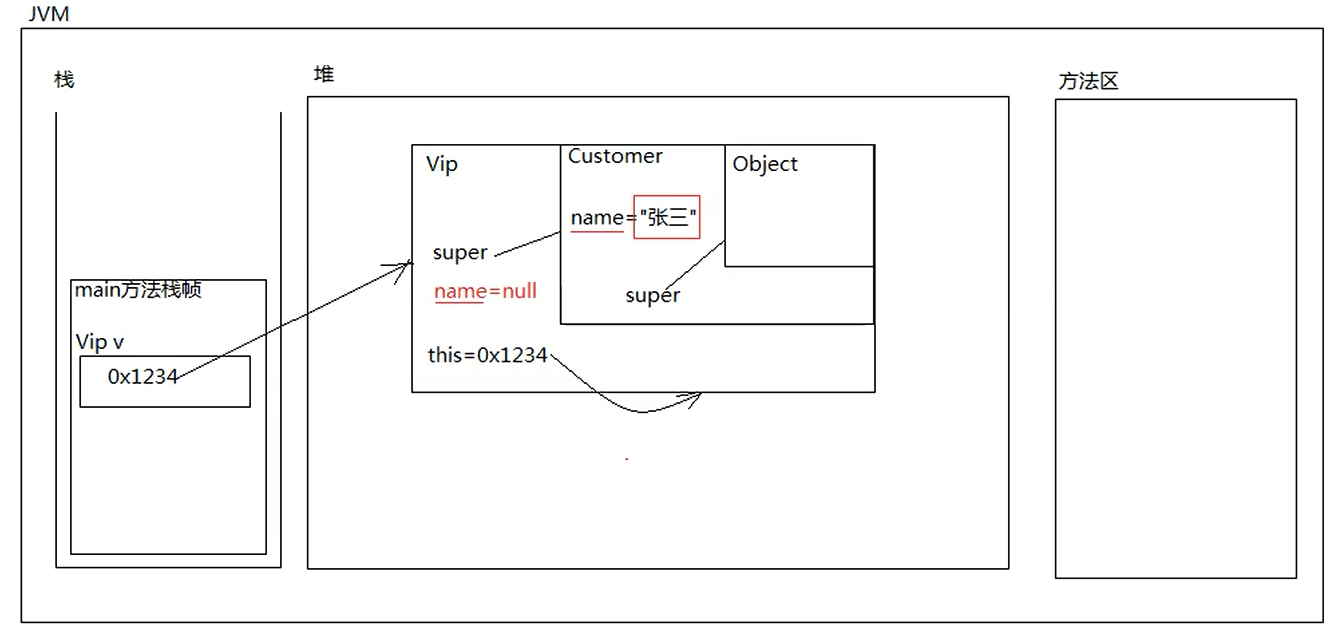概述
1.super能出现在实例方法和构造方法中,不能使用在静态方法中
2.super的语法: "super."、"super()","super."大部分情况下是可以省略的
3.super() 只能出现在构造方法的第一行 ,表示通过当前的构造方法去调用"父类"中的构造方法,目的是:创建子类对象的时候,先初始化父类型的特征
4.重要结论:
当一个构造方法第一行:
- 既没有this(),又没有super()的话,默认会有一个super(),表示当前子类的构造方法调用父类的无参数构造方法
- 子类调用构造方法,一定会先调用父类的构造方法,如果没有显式的写出super(),默认也会调用父类的无参数构造方法,所以,要保证父类的无参数构造方法存在!
例子:
public class SuperTest{
public static void main(String[] atgs){
new B();
}
}
class A{
public A(){
System.out.println("A类无参数构造方法");
}
public A(int i){
System.out.println("A类有参数构造方法");
}
}
class B extends A{
//虽然没有super(),但是B类有参数构造方法中有super(),
//所以子类执行构造方法之前,一定会先执行父类的构造方法
public B(){
this("lisi");
System.out.println("B类无参数构造方法");
}
public B(String name){
//super();
System.out.println("B类有参数构造方法");
}
}

super.什么时候不能省略?
父中有,子中又有,如果想在子中访问“父的特征”,super.不能省略
java通过this. 和 super. 区分父类和子类的属性.
例子:
public class SuperTest{
public static void main(String[] args){
Vip v = new Vip("张三");
v.shopping();
}
}
class Customer{
String name;
public Customer(){};
public Customer(String name){
this.name = name;
}
}
class Vip extends Customer{
//假设子类也有一个同名属性,在java中是允许的
String name;
int age;
public Vip(){};
public Vip(String name){
super(name);
//this.name = null;
}
public void shopping(){
System.out.println(this.name + "is shopping");
System.out.println(super.name + "is shopping");
System.out.println(name + "is shopping");
}
}

内存图:

super 不是引用
super 不是引用。super也不保存内存地址, super也不指向任何对象。
super只是代表当前对象内部的那一块父类型的特征
public class SuperTest{
public void doSome(){
//this是一个引用
System.out.println(this);
//编译错误:需要'.'
System.out.println(super);
}
public static void main(String[] args){
SuperTest st = new SuperTest();
st.doSome();
}
}

super.不仅可以访问属性,也可以访问方法
class Animal{
public void move(){
System.out.println("Animal move!");
}
}
class Cat extends Animal{
//方法覆盖
public void move(){
System.out.println("Cat move!");
}
public void yiDong(){
this.move();
move();
super.move();
}
}
public class SuperTest{
public static void main(String[] args){
Cat c = new Cat();
c.yiDong();
}
}
